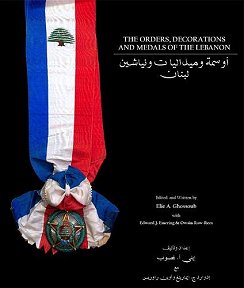The Orders, Decorations and Medals of the Lebanon
by Elie Ghossoub

A lush tome of over 300 pages, the images alone are spectacular whether or not you know anything about the awards of the Lebanon, or even have much interest in them! It covers awards made by the Lebanese government both under the French Mandate (1920-1943) and as the independent Republic of the Lebanon (1943-date), along with unofficial and international awards with a Lebanese connection.
Setting everything in context, the book - which is written in English and Arabic throughout - begins with some historical background showing how the state we know today came into being. After World War 1, the British and French carved up much of the territory belonging to the now-collapsed Ottoman Empire with the French getting the Mandates of Lebanon and Syria, know collectively as the Levant. During the turmoil of World War 2 the then Vichy governor surrendered to Free French and British forces and when Charles de Gaulle visited, local Lebanese leaders asked for independence. Increasingly this was recognised and, although the French tried to cling to some element of control, the Lebanese Chamber of Deputies created a new constitution that curtailed French influence in November 1943. The French attempted to gaol the Lebanese leadership but internation pressure from Britain, the United States and othe Arab nations soon forced them to capituate and on 22 November 1943, the new Republic was born.
The book is made up of four sections: Official Levant/French awards (1920-1943), official awards of Lebanon (1943-date), United Nations awards relating to the Lebanon, and unofficial local and international awards relating to the Lebanon.
Starting with the Levant awards, we first learn of the Mandate's flag - red, white, and blue with a 'cedar of Lebanon' depicted on the white stripe - and then dive straight in to details of each order, decoration, and medal awarded beginning with the Order of Lebanese Merit. Instituted on 16 January 1922, the history of this order is presented in detail including terms of award, its types and classes, and descriptions of the insignia. Normally worn as a chest medal, there was also a sash and star - the Extraordinary Class - for award to heads of state. This is followed by equally-detailed accounts of the Order of the Cedar, the Levant Medal, the Order of Public Instruction, and other awards; all with full-colour (often full-page) illustrations to delight the eye along with all the information you could possibly need to understand the variations of each award.
Next comes the official awards of the Republic of the Lebanon, on which are lavished similar care and attention. The first medal instituted was the Medal of Independence, a silver medal worn on a simple red and white ribbon, awarded to those involved in the formation of the Republic in a single grade. The Order of Merit was amended to reflect changes in the Lebanese flag (now striped red/white/red but still with a cedar tree), and expanded to an extra grade which oddly has a green and white ribbon rather than the red and white used for all other classes. The insignia reflects its history and retains much of the French style, as does the revised National order of the Cedars. Although of a more modern style other medals are equally beautiful, such as the Medal of the Eagle, awarded for aeronautical merit in four classes depending on the recipient's rank rather than their achievements. There's an equivalent Order of the Sea with the most glorious ship design - a Phoenician ship from antiquity. Most of what we might think of as medals are called 'Orders' by the Lebanese and there's a fascinating array. I'm going to enjoy exploring them in more detail when I get around to updating that section of my website!
This is followed by Lebanon-related awards made by the United Nations and other countries - France, Italy, Norway, Germany, and more.
The final section covers unofficial awards... although the first one depicted is an official award from the Syrian Government! Others include 'international orders' with a Lebanese connection, religious awards, and those made by societies and organisations within the country. The book rounds off with a magnificent collection of certificates and other information pertaining to Lebanon.
This book could be recommended for the sheer beauty of the illustrations alone, but that would do a disservice to the detailed research into each award and the background against which they were awarded. If you didn't have an interest in Lebanese awards before, you will after reading this!
Get yours here:
Page last updated: 16 May 2021